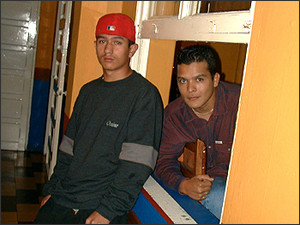
Jorge
(left) and Dorian, Medellin, Colombia, February 28, 2001
MEDELLIN, COLOMBIA, February 28:
Since my arrival yesterday, the first thing everyone asks is whether I've seen THE MOVIES. No Nacimos Pa Semilla, La Vendedora de Rosas, Rodrigo de No Futuro, and the most recent La Virgen de los Sicarios are not documentaries per se. It's significant that all of these films about life in Medellin's communas--the working class neighborhoods famous for the worst violence in the Americas--use the fig leaf of fiction and a few professional actors to "protect" the real people who portray some of the realities of their lives in these films. As I'm discovering, Medellin is a place where that most human of desires--to be recognized and to speak one's truth--can result in an even earlier death than is usual by Colombian standards.And death in Medellin is all too usual. Since January there have been more than 600 murders in this city of about a million and a half. While the Colombian nation as a whole suffers its highest unemployment rate in 100 years--hovering around 20 percent, in Medellin's communas between 70 and 80 percent of the people are without "legitimate" work. Extortion and drugs are significant factors in what economic base exists here.
Between meetings with community groups I've been talking to teenagers. Like their counterparts in the barrios of Los Angeles, they grow up too fast, living with constant tension and violence. And like many kids in LA, they dream of becoming movie stars or famous rap singers.
Dorian got work acting as an extra in the film La Virgen de Los Sicarios. If he can get a bigger part in the new movie going into production about the life of druglord Pablo Escobar, he hopes it will help get some attention for his music video in Miami. Half Dorian's age, Jorge has less international ambitions. He'll be happy if his rap group makes it beyond his communa to the larger world of Medellin nightclubs.